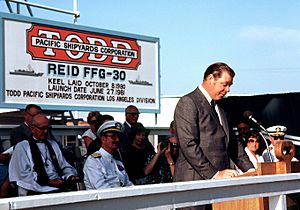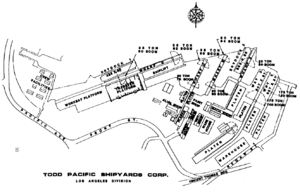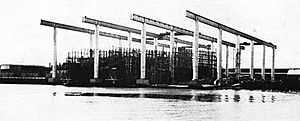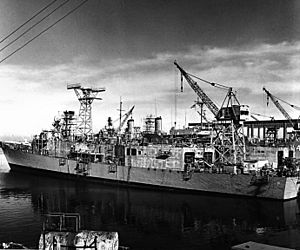Todd Pacific Shipyards, Los Angeles Division facts for kids

Christening and launch of USS Reid (FFG-30), 1981.
|
|
| Industry | Shipbuilding |
|---|---|
| Fate | Liquidated |
| Predecessor | Los Angeles Shipbuilding & Dry Dock Company Todd Shipyards, Los Angeles Division |
| Founded | 1917 |
| Defunct | 1989 |
| Headquarters | San Pedro, Los Angeles, California |
| Parent | Todd Pacific Shipyards, a wholly owned subsidiary of Todd Shipyards Corporation |
Todd Pacific Shipyards, Los Angeles Division was a large shipyard in San Pedro, Los Angeles, California. A shipyard is a place where ships are built and repaired. Before it got its final name, this shipyard was known as Los Angeles Shipbuilding & Dry Dock Company and Todd Shipyards, Los Angeles Division. Under these three names, the San Pedro yard built at least 130 ships. It operated from 1917 to 1989.
The shipyard started during the World War I shipping boom. It survived going bankrupt during the Great Depression. It then built support ships during World War II. The U.S. Navy took control of the yard in late 1943. They asked Todd Shipyards to manage it for the rest of the war. After the war, the yard faced challenges. But it grew again with commercial work in the 1960s and 1970s. It reached its busiest time in 1983 while building frigates for the Navy. The yard closed in 1989 after it did not win a contract to build DDG-51 destroyers. In 2015, the old shipyard site was used as a container terminal.
Contents
Building Ships: Los Angeles Shipbuilding (1917–1943)
The Los Angeles Shipbuilding and Dry Dock Company started in April 1917. Its goal was to build and repair ships in Los Angeles Harbor. This was important during World War I. Fred L. Baker was the company's first president. The yard was built on about 69 acres of marsh land.
The yard got 35 contracts to build cargo ships for the United States Shipping Board. These ships were needed to carry goods during the war. The first ship's main frame, called a keel, was put down on July 23, 1917. By 1920, the yard had a large floating dry dock. This huge dock could lift ships out of the water for repairs. The first four cargo ships were ready in July 1918. Four more were finished before the war ended.
The 35th and last ship for the U.S. Shipping Board was delivered in November 1921. In total, these contracts cost about $72 million. This paid for around 320,000 tons of cargo ships.
Around May 1919, about 6,000 workers at the shipyard went on strike. They wanted a "closed shop," meaning only union members could work there. The yard reopened in July 1919, but many workers did not return.
After the war projects, the shipyard built many tank barges in the 1920s. They also built the famous passenger ship SS Catalina in 1924. In 1925, they built the Los Angeles City #2 fireboat. This boat later became known as the Ralph J. Scott.
In the 1930s, the shipyard mostly repaired ships. Then, before World War II, it got Navy contracts for several support ships. The company faced financial trouble during the Great Depression. Its management changed several times.
On December 8, 1943, the U.S. Navy took control of the Los Angeles shipyard. President Franklin D. Roosevelt signed an order for this. The Navy had invested a lot of money in the yard. But they were worried about how it was being managed. Admiral Harold G. Bowen, Sr. said the yard had poor systems. He also noted that building one ship there cost much more than building a similar ship elsewhere.
The Navy turned over management to Todd Shipyards. Todd already ran several other shipyards. Todd managed the San Pedro yard for the Navy until World War II ended. After the war, Todd bought the shipyard. Admiral Bowen said the Navy taking over saved the government more than $13 million.
During the war, the yard built many important Navy ships. These included three of the four Vulcan-class repair ships. It also built three of the four Currituck-class seaplane tenders. And it built all four Klondike-class destroyer tenders. Under Todd's management, the yard also converted 2,376 ships in the last years of the war.
Todd Shipyards, Los Angeles Division (1946–1977)
Todd Shipyards bought the Los Angeles shipyard after World War II. It began operating as the Todd Shipyards, Los Angeles Division in November 1946. During the war, about 20,000 people worked at the yard.
After the war, the yard focused on ship repair and converting ships. It also did machine work for other industries. Business slowed down until the Korean War. But it dropped even more after that war ended in 1953.
In the early 1950s, the Los Angeles division worked on projects for Disneyland. They built a copy of the sternwheel riverboat Mark Twain. They also built eight small tourist submarines. And they made the masts and sails for the Sailing Ship Columbia.
After 1958, Todd invested a lot in the Los Angeles yard. They built many cargo ships for different companies. In the 1960s, the yard built two cruisers, the England and the Fox. It also built seven Knox-class frigates in the late 1960s. They also converted two other Navy ships.
The Los Angeles division also made special pipes for the United States Atomic Energy Commission. They built test missiles for the Polaris missile program. And they made a base for a tracking antenna used by NASA.
In the early 1970s, the yard built four medium-sized tankers. But contracts for eight larger tankers were canceled in 1975. This happened during the 1970s energy crisis and after the 1973 oil crisis.
Todd Pacific Shipyards, Los Angeles Division (1977–1989)
On October 1, 1977, Todd Pacific Shipyards Corporation was formed. It was a part of Todd Shipyards Corporation. Todd's shipyards in Seattle and Los Angeles became part of this new company.
The San Pedro yard built eighteen Oliver Hazard Perry-class frigates. In 1983, the yard had 5,600 workers. By 1989, only 400 people worked there. The yard used about 112 acres of land, which it leased from the Port of Los Angeles.
The main company, Todd Shipyards, faced financial difficulties in August 1987. The Los Angeles division closed in 1989. This happened after it finished its last frigate, the USS Ingraham. Todd had tried but failed to win a contract to build Arleigh Burke-class destroyers. The land where at least 130 ships were built over 70 years was given back to the Port of Los Angeles. In 2015, this area was known as Berth 100 / West Basin Container Terminal.





